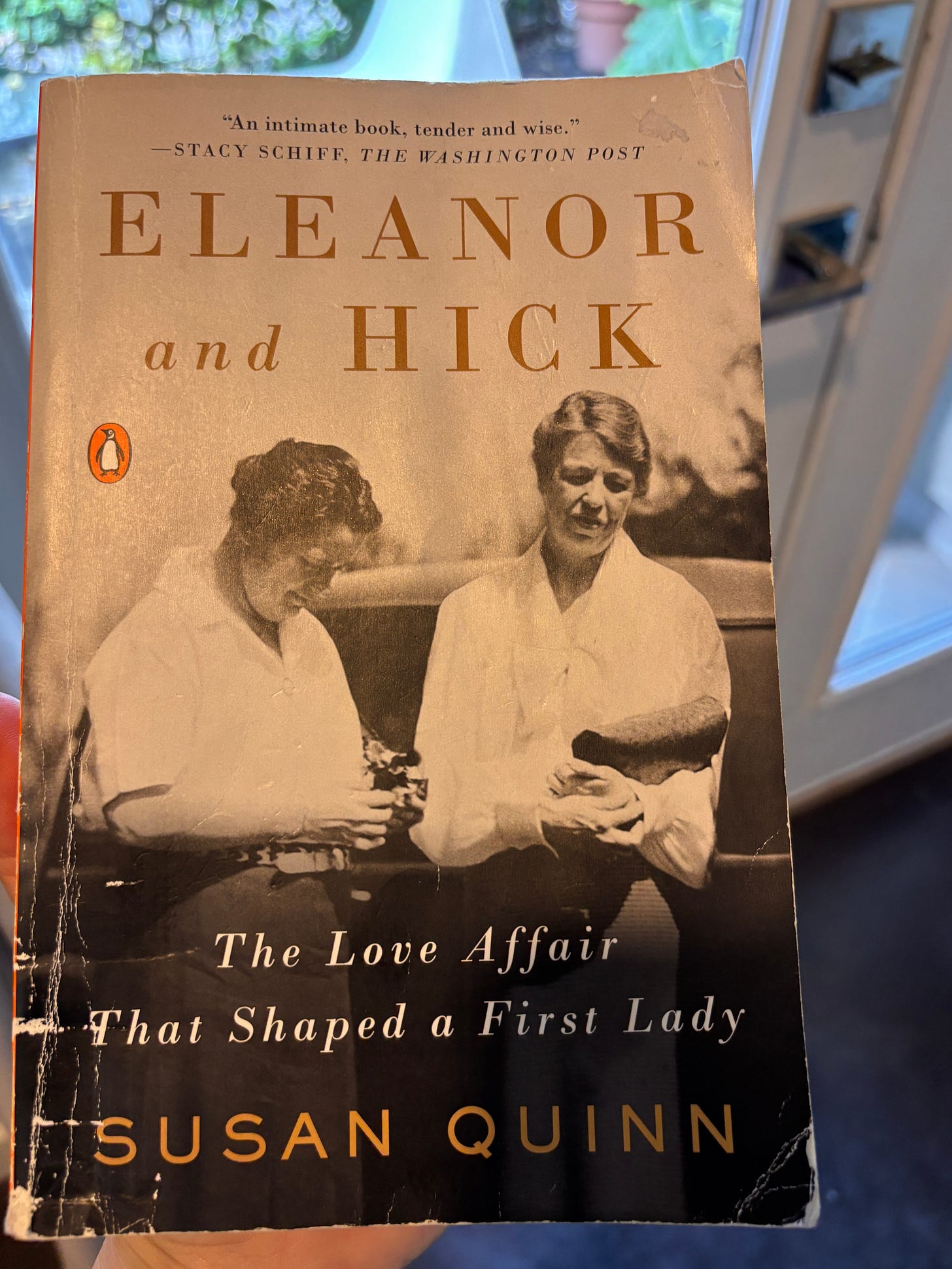Eleanor and Hick: The Love Affair that Shaped a First Lady (Susan Quinn)
The one that sat on my shelf too long.
I’m not sure how Eleanor & Hick made its way to my bookshelf, but it languished there far too long1 before I discovered it’s an astonishingly compelling read.
You’ve got the gist from the title: nonfiction account of Eleanor Roosevelt’s relationship with Lorena Hickok (Hick), primarily sourced from the over 3,300 letters2 they exchanged (from 1932 to Eleanor’s death in 1962). Hick and Eleanor met when Hick covered covered Eleanor for the Associated Press. By the time Eleanor became First Lady, Hick resigned from the AP and moved into the White House with the Roosevelts (where she’d live on-and-off throughout their thirteen-year stay3). Hick was entrusted with both sides of the correspondence and donated it to the Roosevelt Presidential Library to be opened 10 years after her death.
Quinn reports that the first journalist to access the letters was ambivalent (at best) to consider that Eleanor Roosevelt had a long-term, loving, romantic relationship with a woman. Her resulting 1980 account muffled the story. Quinn’s 2016 book is a celebration not only of this specific relationship, but of several powerhouse lesbian couples in Eleanor’s network. Marion Dickerman and Nan Cook, suffragettes with whom she started a furniture-making business (and collaborated on political and educational efforts) get the most coverage in this account. (Also special: I am a sucker for the idea of women’s clubhouses. It’s not a stretch to say the Val-Kill cottage on the Roosevelt estate in Hyde Park, NY where Eleanor lived for a time with Dickerman and Cook— and later with her personal secretary Malvina "Tommy" Thompson— was a clubhouse of the best kind.)
Eleanor and Hick’s relationship wasn’t frictionless. In modern parlance, Quinn gives the idea Hick ‘was on the hook' for Eleanor, whose attention was constantly divided between political duties, her six-day/week column “My Day” (plus speaking engagements and radio appearances), and a constant avalanche of correspondence.
“more interested in the person than the personage. I resented the personage and fought for years an anguished and losing fight against the development of the person into the personage. I still prefer the person, but I admire and respect the personage with all my heart!”
Lorena Hickok to Eleanor Roosevelt
A sadness seemed to hang about Eleanor. Quinn makes the case that Eleanor often set things up so that she was the third wheel—first with Marion and Nan at the Val-Kill cottage, later with Dr. David Gurewitsch and his wife Edna (with whom she shared an apartment at the end of her life).
One part I ESPECIALLY liked was many of the women featured centered their lives around their friendships. My grandmothers modeled this, despite having different circumstances. My married, homemaker grandmother visited a friend for coffee most weekday mornings for much of her adult life. My widowed, working grandmother had a house nearly constantly full of friends and a roster of friends with whom she traveled.
Eleanor and Hick was a bring-it-in-the-car-just-in-case read. It leaves me eager to check out:
Blanche Wiesen Cook’s three-volume biography of Eleanor Roosevelt
Doris Kearns Goodwin’s No Ordinary Time
Kelly O’Connor McNees’s fictionalized account told from Hick’s perspective in
Tell me, what’s your favorite untold love story? I’d love to add another to my list.
Things that should light up: 1) books I pass over on my bookshelf, but will really, really like. 2) a 10-year-old’s retainer when it’s not in her mouth.
Can you imagine? That’s an average of 2 letters a week over their THIRTY YEAR correspondence.
She wasn’t the only non family member to live there. Sounds fun.




